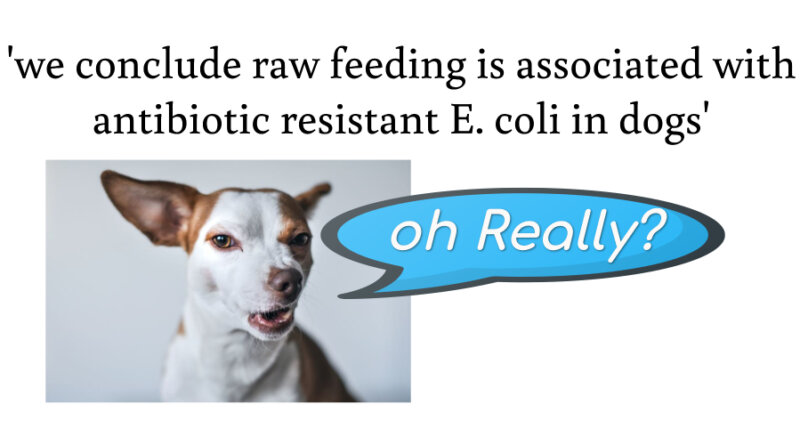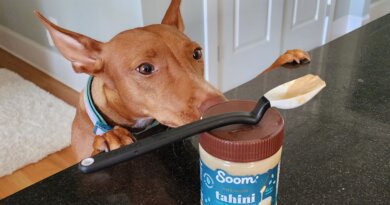New Study Concludes Raw Pet Food is an Antibiotic Resistant Bacteria Threat, but… – Truth about Pet Food
A new study – a new suspicious and VERY confusing study – claims that raw pet food is a risk to carry antibiotic resistant E. coli. They go so far as stating that raw pet foods are an antibiotic resistant bacteria “threat”. But…
The study included 223 dogs from one geographic area in the United Kingdom. Each family provided researchers a stool sample from their dog which was tested for E.coli contamination. Their results appear to state that 108 of the total 223 dogs stool tested positive for an antibiotic resistant bacteria; 32 dogs that consumed raw pet food and 76 dogs that ate undisclosed styles of pet food.
Concern #1
Even though this study associated the risk of antibiotic resistant E. coli ONLY with raw pet food, it does not disclose what other styles of pet food were consumed by the dogs in the study. Of the 108 dogs whose stool tested positive, only 32 of those dogs consumed raw pet food. The study does not disclose what style of food the other 76 dogs that tested positive ate. Why?
What if all of the 76 antibiotic resistant E. coli positive dogs that food type was undisclosed consumed kibble? (Because kibble is the most popular style of pet food, this is VERY possible.) If it was, then the outcome of the study would be completely different. IF those 76 dogs consumed kibble, the study would have shown that kibble would be the greatest risk with 70% of all antibiotic resistant E. coli positives.
Concern #2
The study asked participants some interesting questions regarding potential exposures to antibiotic resistant E. coli. Such as: did the dog walk on farmland or swim/play in lake, river, pond, or salt water? And the study provided negative and positive test results with each of these exposures. With the question did the dog walk on farmland, 142 of 223 participants responded yes. Of those 142 farm-walker dogs, 69 of their stools tested positive for an antibiotic resistant E. coli.
Unfortunately, the study doesn’t clarify what other risk factors the raw fed dogs (and the undisclosed style fed dogs) were exposed to. Such as, if the 32 of the total 223 dogs that tested positive for an antibiotic resistant E. coli ate raw pet food…did they also walk on farmland or swim in a pond (other risk factors of the study)? How many of the raw fed dogs said yes to other risks? How many of the undisclosed styles of pet food said yes to other risks? The study neglects to disclose this information.
They did seem to hand pick six results (six of 108 positives) that showed only one example of another risk exposure for a raw fed dog (see Table 2). However, they did not include information for any other style of pet food.
Concern #3
The study used whole genome sequencing to determine the specific species of E.coli found in each stool sample. In this section they provided data for 36 dogs, 18 raw fed and 18 unknown style of pet food. Significantly, the exact same strains of antibiotic resistant E. coli was found in BOTH raw fed dogs and the dogs fed an undisclosed styles of pet food.
As example, Table 3 of the study states “Dog 9” stool – a raw fed dog – contained “ST162 E. coli”. But…”Dog 14” – a dog that did NOT consume raw pet food – stool also contained “ST162 E. coli”.
This same similar E. coli strains between both raw pet food fed dogs and undisclosed style of pet food fed dogs continues through all 36 results provided in Table 3. So…if identical strains of an antibiotic resistant bacteria was found in BOTH raw pet food fed dogs and perhaps kibble fed dogs – how in the world can this study come to the conclusion that raw pet food is the certain “threat”?
Concern #4
It does not appear that this study tested any pet foods that the antibiotic resistant E. coli dogs consumed to definitively link the bacteria to the pet food. If the scientists truly believed that raw pet food is a risk, wouldn’t it have been appropriate to confirm their belief thru pet food testing? It could have been so simple. When pet owners provided researchers a stool sample from their pet, they could have also provided a small pet food sample at the same time.
Or…would testing of pet food samples have disproved their intended purpose? (To scare pet owners away from raw pet food.)
The name of this study is: “Evidence that faecal carriage of resistant Escherichia coli by 16-week-old dogs in the United Kingdome is associated with raw feeding”. Personally, I did not read any “evidence” in the study to prove that raw pet food is the association.
Disclaimer: I’m not a scientist. I’ve read a lot of studies and this one stands as the most confusing I’ve ever read. (I wonder if confusion was their intention.) Because I am not a scientist and because this study was so confusing, it is possible that I am misinterpreting the results. If I learn of anything I have reported here is incorrect – this post will be edited.
Wishing you and your pet the best –
Susan Thixton
Pet Food Safety Advocate
TruthaboutPetFood.com
Association for Truth in Pet Food

Become a member of our pet food consumer Association. Association for Truth in Pet Food is a a stakeholder organization representing the voice of pet food consumers at AAFCO and with FDA. Your membership helps representatives attend meetings and voice consumer concerns with regulatory authorities. Click Here to learn more.
What’s in Your Pet’s Food?
Is your dog or cat eating risk ingredients? Chinese imports? Petsumer Report tells the ‘rest of the story’ on over 5,000 cat foods, dog foods, and pet treats. 30 Day Satisfaction Guarantee. Click Here to preview Petsumer Report. www.PetsumerReport.com
Find Healthy Pet Foods in Your Area Click Here

The 2022 List
Susan’s List of trusted pet foods. Click Here to learn more.





indianpharmacy com: top 10 pharmacies in india best online pharmacy india
deep web links tor marketplace
deep web links deep web drug links